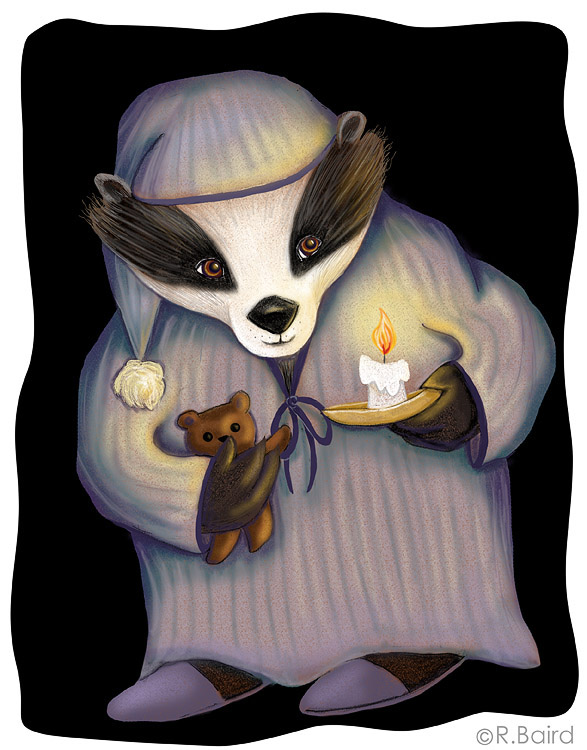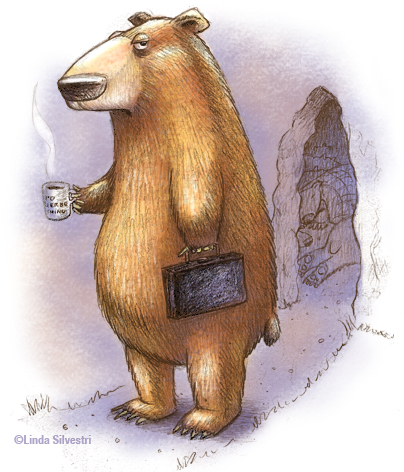Viewing: Blog Posts Tagged with: hibernate, Most Recent at Top [Help]
Results 1 - 6 of 6
Blog: the dust of everyday life (Login to Add to MyJacketFlap)
JacketFlap tags: Winter, groundhog, Hidden Pictures, THEMED ART, Patrick Girouard, hibernate, Add a tag
Blog: sketched out (Login to Add to MyJacketFlap)
JacketFlap tags: hibernate, illustration, illustration friday, drawing, humor, sketch, children's illustration, sketchbook, sketching, bear, early riser, Add a tag
Conversation between my husband and I, a few years ago, after arriving at Sequoia National Park’s Wuksachi Lodge.
Linda: “Did we get all the food out of the trunk? I don’t want to wake up to bears raiding our car.”
Tom: “Yes, we got it all.”
Linda: “Are you sure? Because bears can smell any little thing. Even gum.”
Tom: “I think we’ll be fine honey.”
Linda: “Wait, there are some vitamin waters left in the cooler.”
Tom (slightly less patient): “It’ll be fine.”
Linda (becoming slightly shrill): “Bears can smell through plastic. Rangers told me that once.”
Tom: “Hold on a minute, it’s winter. Aren’t bears supposed to hibernate in winter?”
Linda: “OH YEAH! Hee hee. That’s right… whew.”
Linda: “… Wait! You know, there may be some early risers.”
Tom: “I’ll bring the vitamin waters in.”
……………………………………………………………………………………………………………….
When I saw the Illustration Friday theme this week was hibernate, I remembered a post I did back in 2008 while on vacation.
I remember, blogging almost every single day at the time and actually brought along with my laptop, a scanner, so I could scan and upload any sketches I did while at the lodge. Oh to be that committed again.
Anywho, I threw some color on the old sketch and reposted, once again, at the last minute.
Blog: Whateverings (Login to Add to MyJacketFlap)
JacketFlap tags: Links, Illustration Friday, art, cartoon, comic, Spring, sleep, blanket, bear, hibernate, Add a tag
Another “it’s been a while”…
Check out the other entries at Illustration Friday.
Blog: A Mouse in the House (Login to Add to MyJacketFlap)
JacketFlap tags: illustration, Illustration Friday, animals, IF, children's illustration, digital art, roberta baird, artwork, houston, a mouse in the house, badger, hibernate, www.robertabaird.com, Add a tag
 May sleep envelop you as a bed sheet floating gently down, tickling your skin and removing every worry. Reminding you to consider only this moment. ~Jeb Dickerson
May sleep envelop you as a bed sheet floating gently down, tickling your skin and removing every worry. Reminding you to consider only this moment. ~Jeb Dickerson
Blog: Ginger Pixels (Login to Add to MyJacketFlap)
JacketFlap tags: children's book illustration, Ginger Nielson, brown bears, hibernate, Add a tag
Blog: Sylvan Dell Publishing's Blog (Login to Add to MyJacketFlap)
JacketFlap tags: Teachable Moments, hibernate, hibernation, migrate, muskrats, terrapins, tundra swans, winter, animals, migration, moose, eagles, raccoons, wolves, sea turtles, loons, track, humpback whales, salmon, Add a tag
As the weather turns cold and winter approaches, we add layers of clothes and turn up the heat. What do animals do to prepare for the cold?
Adapt:
Some animals prepare for cold weather by gathering food and storing it for the upcoming winter when it will be harder to find. Can you think of any animals that do this?
Other animals are able to find food through the winter and grow thicker layers of fur. Can you think of any animals that do this?
Hibernate:
Some animals go into a deep sleep over the winter. They usually will eat lots of food in the fall then go to sleep in a den or a deep burrow. A true hibernating animal’s breathing slows way down and its body temperature drops.
Some animals sleep heavily for long periods but will wake up every occasionally to eat.
Migrate:
Seeing birds flying south in the fall is common. They are not only flying to warmer climates for warmth but to be able to find food that is more readily available. They usually follow the same routes every year. Some animals learn the routes by following other animals (mother?) but other animals seem to know where to go by instinct. Scientists aren’t sure how the animals know how, when, or where to go.
Birds are not the only animals that migrate to warmer weather during their winters. Can you think of any other animals that go south for the winter? Do you know any people who go south for the winter? Where do they go?
Not all migrations have to do with warmer weather. Some animals migrate as part of their life cycle. Life cycle migrations may take place every year and similar animals may gather in special spots to find mates or to have babies.
Other animals might migrate only when giving birth or to lay eggs in a specific location (where they were hatched).
Websites of interest:
ParkWise (Alaska National Parks’ e-classroom): Migration: http://www.nps.gov/akso/parkwise/Students/ReferenceLibrary/general/MigrationBasics.htm
Tracking animals. Sometimes scientists put satellite collars on animals so they can track their movements. This helps us to understand how, where, and when animals move around the earth. Here are some sites where you can follow various animals:
WhaleNet: (tracks seals & whales) http://whale.wheelock.edu/whalenet-stuff/stop_cover.html
SeaTurtle.org: (tracks sea turtles) http://www.seaturtle.org/tagging/
Journey North: (tracks whooping cranes, hummingbirds, monarchs and other animals) http://www.learner.org/jnorth/
Alaska Seal Life Center: (tracks seals) http://www.alaskasealife.org/New/rehabilitation/index.php?page=rehab-tracking.php
Wild Tracks: (manatees) http://www.wildtracks.org/Florida/home.html
Ideas for experiential learning:
Keep a wildlife journal for one week. Identify what animals you see and what they are doing. Do you think they are getting ready for winter? Do you see any signs of animals even though you might not see the animals themselves?
• Bird feathers
• Chewed pinecones
• Chewed acorns or nuts
• Scat (droppings)
• Animal tracks
• Bones
What are some ways that humans prepare for cold weather? How do the clothes we wear change with the seasons? Why?
Do we eat any foods now that we might not eat during the hot summer? What foods and why?
In the book, Whistling Wings, the young tundra swan flies about 1,000 miles without stopping to rest or eat.
• Look at a map and figure out how far 1,000 miles is from where you live. Could you walk there without stopping to slee







Love your style!
She really was blogging from the Wuksachi Lodge, five feet of snow outside.
http://www.flickr.com/photos/visualkaos/2335930454/sizes/l/in/photostream/
Yes this is great, love the expression on the bears face!
Wonderful! I really love the expression too
I love the illustration and the dialogue…. hehehe
So were you attacked by bears? Nice painting
Love the story. Love the bear. Actually lol-ed.
the story and the bear are both wonderful
Lol, that sounds so like me and what I’d be saying. The look on the bears face is Hillarious.
I’m the bear still passed out in the cave– love it!